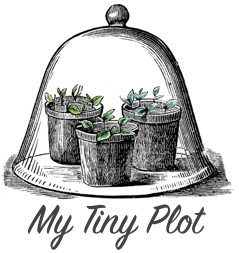Ten Steps to Blight-free Tomatoes
>
It’s about this time of year that I start to fuss and worry about blight on my Tomatoes. I’ve never really been able to relax since The Year the Tomatoes Died. So I thought I would re-publish this little article that I wrote last year for the Guardian Gardening blog. I will be doing all of this again this year, come rain or shine :)
When I first starting vegetable gardening in 2005 growing Tomatoes was a doddle, a breeze. Just bung in the plants, water them a bit, feed them a bit and ta-da! right on que at the end of August you’d be eating your own home-grown tommies.
Not anymore. Over the last few years, our summers have been, well, disappointing. And if we’re deluged in rain again this year it means one thing; that growing outdoor Tomatoes in the UK will be more of a battle with wind and rain in an effort to avoid the dreaded…gulp… blight.
As most will know, Tomato blight is a nasty disease that starts with small brown patches on stalks and leaves but soon progresses to the fruits.
If I had a greenhouse I’d take my Tomatoes under cover. But since I don’t have that option (and frankly the thought of ‘not’ growing Tomatoes makes me feel a little nauseous) then there’s only one thing for it – to fight.
Here’s my plan.
- Grow (or buy) vigorous, healthy plants.
- Don’t plant Tomatoes in the same spot as last year.
- Plant disease-resistant varieties (Ferline, for example)
- Remove the bottom leaves up to the first truss of fruits to avoid splash back
- Remove and destroy all plant waste after the growing season
- Avoid watering on to the leaves. Water directly to the roots and don’t handle plants when the vines are wet.
- Control weeds in and around the plants. Weeds serve as hosts for insects and disease.
- Control pests (particularly aphids) which may transmit disease from plant to plant.
- Remove plants as soon as the tell-tale brown patches are seen. Wash hands and tools with a detergent after handling affected plants.
- Choose a sunny location and provide a removable rain cover if possible.
- Pray (or at least ask the rain gods to take pity on me).
So there you have it my 10 – err 11 point plan. If anyone has any more suggestions then please post them in the comments. When fighting Mother Nature you need all the weapons you can get.
 My Tiny Plot
My Tiny Plot



Last year my tomatoes were decimated (which is unusual for the US Northeast). This year I am planting Legend and Juliet — both have some resistance. But, I also planted a super-early variety — Forth of July. I grew it from seed at home in 6 inch pots. In the ground on May 20th, and already has 2 clusters of tiny green fruit and two clusters of flowers. With luck, I will have a few toms before the blight reaches my plot.
Growing you own veg is quite a learning curve isn’t it, thanks for those tips :-)
We had a late blight epidemic last year (2009) that destroyed over 90% of organic tomatoes and 50% of organic potatoes in the state of Maine, as well as much of the northeastern United States. It was caused by the distribution of infected tomato seedlings by a large plant nursery called Bonnie Plants, which is based in Georgia. In combination with an unusually wet and cloudy year, the fungal spores spread like wildfire, contaminating the entire region.
One of the best things a person can do to prevent late blight is to buy only certified seed potatoes, and buy seedlings only from LOCAL trustworthy sources (i.e., not big box stores) or to start your own seedlings, since seeds cannot be contaminated with blight (except in rare cases).
See more information at:
http://orizabafarm.wordpress.com/category/late-blight/
One big thing I see missing from your list is starting your own plants. Nurseries are notorious for harboring disease. I have never had blight or wilt on my tomatoes. I start all my own plants and rotate my crops on a five year rotation. I also never trellis tomatoes but this of course isn’t practical if you don’t have the space. Sprawling tomatoes are much healthier than trellised so if you have the room let them sprawl. Your harvest will be much greater on sprawling tomatoes as well, nearly double. Also if you are getting early blight I would not tear my plants our immediately but instead try to control it with organic fungicides and removing infected parts. Late blight I would remove the plant immediately it is more devastating. This is how I deal with blight on potatoes. Also keep in mind you need to move your plants at least ten feet to be considered a rotation. Any thing less and your still in infected soil.
Many good tips- I’ll try them out.
Have a nice Sunday!
Thanks for the tips, I lost all my tomatoes to blight last year, it was my first ever year growing them & they were in the greenhouse! I didn’t want to put any potatoes in this year as the garden is just next to the greenhouse & I thought their presence would increase the chance of infection, my dad however, decided to be helpful when I was busy at uni & planted some, so I’m dreading a replay of last year. I’ve grown a supposed blight resistant variety called ‘Fantasio’ so I’ll just have to hope for the best but Northern Irish summers are ideal for blight to take hold.
I decided earlier this year that I wasnt going to grow tomatoes after the past few blight ridden years. But I found myself lusting after stripey and yellow toms in a salad, after watching Jamie Oliver do one of his recipes on TV.
So I have grown Tigerella and Sungold this year, I usually go for Gardeners Delight or Garden Pearl.
I hope fingers crossed it will be okay, please be okay this year… other wise I wont be trying again, which is just to sad a thought!
Thank you for your tips, I will follow them rigorously, and will let you know the results.
Good luck all you tom growers!
I too have been struck by blight in previous years, which is very cross-making, esp. after nuturing plants. I grew Ferline last year, and although they didn’t get blight (which was good), they didn’t taste home grown (which was bad). They are very thick-skinned, which I guess makes them resistant to blight, but really didn’t taste of anything at all. I wouldn’t grow them again.
I am growing a selection of cherry varieties this year, half in the new greenhouse and half outside. So fingers crossed for a blight free year, I don’t know if I can bear another year of blight.
Thank you for the tips. After growing my own tomatoes for many years with no problems at all, I was devastated to find mine had blight last year so I’m really grateful for some tips about how to avoid it!
Another few varieties you may want to try which are blight resistant are Ferline which is resistant to fusarium and verticillium wilt and also Legend which has impressive blight tolerance.
Good tips – I think I had beginners luck on my side last year
This has cheered me up no end to know that my chickens are actually doing a me a favour by stripping the bottom of my tomato plants of their leaves.